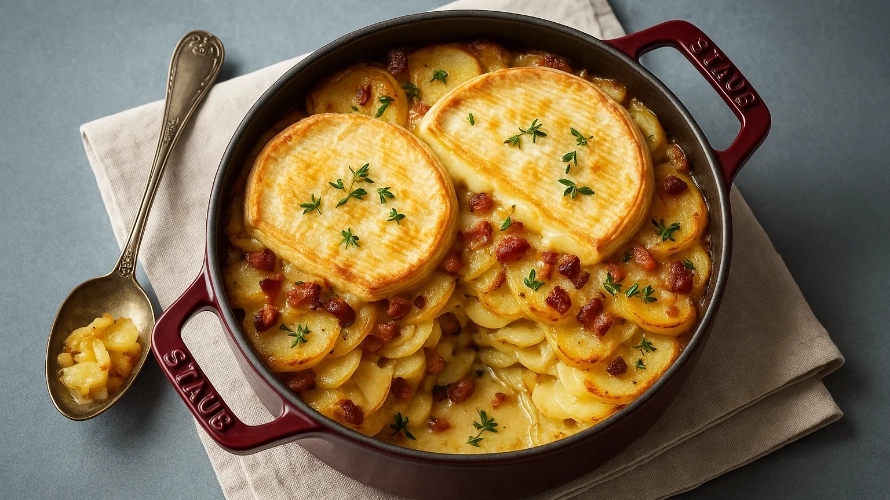Prep time
30 minutes
Cooking time
45 minutes
Difficulty
Serves
4-6
Ingredients
- 1 kg firm potatoes (Charlotte, Roseval, or similar)
- 200–300g vegetarian smoked lardons
- 1 large onions
- 1 whole Reblochon cheese (450g)
- 250ml double cream
- 1 small glass dry white wine from Savoie (optional, but used in many Savoyard homes)
- Salt, black pepper, nutmeg (optional)
- 1 tbsp oil or butter
Equipment
- Large saucepan
- Large frying pan
- 30 x 20cm ovenproof baking dish
- Knife and chopping board
- Slotted spoon
- Wooden spoon or spatula
Instructions
1. Cook the potatoes
Wash the potatoes and cook them whole, skin on, in a large pot of salted water for about 20 minutes, until just tender but not falling apart as they will finish cooking in the oven. Drain, let cool slightly, then peel and cut into thin slices.
2. Prepare onions and lardons
Peel and finely slice the onions. Heat the oil or butter in a frying pan, add the onions and cook gently until translucent. Add the vegetarian smoked lardons and fry together until both are golden and fragrant.
3. Deglaze (optional)
Pour in the white wine and let it bubble for a minute to deglaze the pan. Remove from the heat and stir in the double cream. Season with pepper and a pinch of nutmeg. Taste before adding salt, as vegetarian smoked lardons and cheese are already salty.
4. Layer the tartiflette
In your gratin dish, layer potatoes, then some of the onion-lardons-cream mixture. Repeat as many times as you like, making sure each layer is well distributed.
If you want it extra cheesy, you can buy a second Reblochon and add slices of cheese in the layers as well as on top. This guarantees gooey cheese throughout the whole dish.
5. Add the Reblochon
Slice the Reblochon in half horizontally to make two thinner rounds. Place the halves rind side up over the top of the dish (or cut into thick slices and distribute evenly).
6. Bake
Bake in the centre of the oven for 45–50 minutes, until the cheese is melted, golden, and bubbling, and the potatoes are tender all the way through.
7. Serve
Let it cool slightly, then serve just warm or at room temperature. Don’t forget the crown for whoever finds the fève!
Notes
- Reblochon is essential for authenticity. If you can’t find it, a strong, creamy cheese like raclette or a robust brie will do, but it just won’t be quite the same.
- Some French cooks skip the cream, letting the cheese do all the work, but most traditional recipes include it for extra richness.
- Tartiflette is pure winter comfort, don’t even think about calories!
Drink pairing
Apremont, Chignin, or Roussette de Savoie
About this recipe
Tartiflette is a dish that feels ancient, but its story is a brilliant blend of Alpine tradition and clever modern marketing. The name “tartiflette” comes from the Savoyard word for potato, tartifla, and the dish hails from the Savoie region in the French Alps, where hearty, warming food is a way of life.
Despite its rustic, comforting character, tartiflette as we know it today is actually a relatively recent invention. It was created in the 1980s by the Syndicat Interprofessionnel du Reblochon—the official body representing Reblochon cheese producers, as a way to boost sales of their cheese, which was facing overproduction at the time. The dish draws inspiration from a much older local recipe called péla, a simple gratin of potatoes, onions, and cheese cooked in a long-handled pan, but péla didn’t use Reblochon in quite the same way, nor did it have the creamy, over-the-top richness that defines tartiflette today!
The classic tartiflette is made with potatoes, onions, lardons (bacon), and a whole Reblochon cheese, all baked together until bubbling and golden. Sometimes a splash of Savoie white wine or a spoonful of crème fraîche is added for extra richness, but the heart of the dish is always the combination of melting Reblochon and tender potatoes.
Tartiflette quickly became a staple in Alpine ski resorts and French homes alike, especially as an après-ski meal, hearty, convivial, and perfect for sharing after a day on the slopes. Its popularity soared through the 1990s and 2000s, and today, it’s considered a symbol of Savoie’s generous, cheese-loving cuisine.
So, while tartiflette might not be as old as it looks, it’s a dish that captures the spirit of the Alps: simple ingredients, local cheese, and a big dose of comfort, just what you need when the snow is falling outside
Share your feedback and spread the love!
If you try this Tartiflette recipe, I’d love to hear how it turns out! Leave a ★★★★★ rating and your thoughts in the comments, it helps fellow food lovers discover this recipe too. Snap a photo and tag us @frogsinbritain on Instagram or TikTok if you’re sharing your bake online. Don’t forget to save this recipe to Pinterest so you’ll always have it handy for your next French-inspired meal!
Disclosure: This post contains sponsored content and/or affiliate links. If you make a purchase through these links, I may receive a small commission at no extra cost to you. All opinions are my own!

